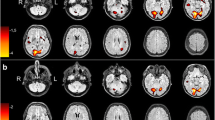Abstract
Objective
Focal cortical dysplasia (FCD) is one of the causes of epilepsy, but its diagnosis by MRI remains difficult. The purpose of this study was to evaluate the use of subtraction ictal SPECT coregistered to MRI (SISCOM) and MRI to detect the epileptogenic focus in patients with FCD.
Methods
MRI and SISCOM findings of 20 patients with pathologically proven FCD were retrospectively reviewed. MRI was visually assessed for detecting FCD. SISCOM was evaluated by a new method selecting a higher standard deviation (Z score) area as the epileptogenic focus. We scored the detectability in both SISCOM and MRI while referring to the pathology.
Results
Sixteen patients agreed with pathology on SISCOM and 14 patients on MRI. Although MRI could not point out foci in two cases of FCD type I, SISCOM could do so in both of them. A combined diagnosis of SISCOM and MRI agreed with the pathology in 18 patients.
Conclusions
Narrowing the target by elevating the Z score on SISCOM seems to be an appropriate method to detect the foci without the need for expertise of radiologists. We recommend this combined method of SISCOM and MRI for presurgical evaluation in patients with FCD.



Similar content being viewed by others
References
Palmini A, Najm I, Avanzini G, Babb T, Guerrini R, Foldvary-Schaefer N, et al. Terminology and classification of the cortical dysplasias. Neurology. 2004;62:S2–8.
Andreasen AR, Lassen NA. Single-photon emission computed tomography in temporal lobe epilepsy. In: Dam M, Gran L, editors. Comprehensive epileptology. New York: Raven Press; 1991. p. 375–84.
O’Brien TJ, So EL, Mullan BP, Hauser MF, Brinkmann BH, Bohnen NI, et al. Subtraction ictal SPECT co-registered to MRI improves clinical usefulness of SPECT in localizing the surgical seizure focus. Neurology. 1998;50:445–54.
Matsuda H, Matsuda K, Nakamura F, Kameyama S, Masuda H, Otsuki T, et al. Contribution of subtraction ictal SPECT coregistered to MRI to epilepsy surgery: a multicenter study. Ann Nucl Med. 2009;23:283–91.
Wichert-Ana L, Mazzoncini P, Oliverira LF, Fernandes RMF, Velaso TR, Santos AC, et al. Ictal technetium-99m ethyl cysteinate dimer single-photon emission tomographic findings in epileptic patients with polymicrogyria syndromes: a subtraction of ictal-interictal SPECT coregistered to MRI study. Eur J Nucl Med Mol Imaging. 2008;35:1159–70.
Valenti MP, Froelich S, Armspach JP, Chenard MP, Dietemann JL, Kerhli P, et al. Contribution of SISCOM imaging in the presurgical evaluation of temporal lobe epilepsy related to dysembryoplastic neuroepithelial tumors. Epilepsia. 2002;43:270–6.
O’Brien TJ, So EL, Cascino GD, Hauser MF, Marsh WR, Meyer FB, et al. Subtraction SPECT coregistered to MRI in focal malformations of cortical development: localization of the epileptogenic zone in epilepsy surgery candidates. Epilepsia. 2004;45:367–76.
Kaiboriboon K, Lowe VJ, Chantarujikapong SI, Hogan RE. The usefulness of subtraction ictal SPECT coregistered to MRI in single- and dual-headed SPECT cameras in partial epilepsy. Epilepsia. 2002;43:408–14.
Ahnlide JA, Rosén I, Tech PLM, Källén K. Dose SISCOM contribute to favorable seizure outcome after epilepsy surgery? Epilepsia. 2007;48:579–88.
Woods RP, Cherry SR, Mazziotta JC. Rapid automated algorithm for aligning and reslicing PET images. J Comput Assist Tomogr. 1992;16:620–33.
Matsuda H, Ohnishi T, Asada T, Li ZJ, Kanetaka H, Imabayashi E, et al. Correction for partial-volume effects on brain perfusion SPECT in healthy men. J Nucl Med. 2003;44:1243–52.
Engel J Jr, Van Ness PC, Rasmussen TB, Ojemann LM. Outcome with respect to epileptic seizures. In: Engel Jr J, editor. Surgical treatment of the epilepsies. New York: Raven Press; 1993. p. 609–21.
Taylor DC, Falconer MA, Burton CJ, Corsellis JAN. Focal dysplasia of the cerebral cortex in epilepsy. J Neurol Neurosurg Psychiatry. 1971;34:369–87.
Colombo N, Salamon N, Raybaud C, Özkara C, Barkovich AJ. Imaging of malformations of cortical development. Epileptic Disord. 2009;11:194–205.
Van Paesschen W. Ictal SPECT. Epilepsia. 2004;45:35–40.
Phal PM, Usmanov A, Nesbit GM, Anderson JC, Spencer D, Wang P, et al. Qualitative comparison of 3-T and 1.5-T MRI in the evaluation of epilepsy. Am J Roentgenol. 2008;191:890–5.
Conflict of interest
We declare that we have no conflict of interest.
Author information
Authors and Affiliations
Corresponding author
Rights and permissions
About this article
Cite this article
Kimura, Y., Sato, N., Ito, K. et al. SISCOM technique with a variable Z score improves detectability of focal cortical dysplasia: a comparative study with MRI. Ann Nucl Med 26, 397–404 (2012). https://doi.org/10.1007/s12149-012-0585-4
Received:
Accepted:
Published:
Issue Date:
DOI: https://doi.org/10.1007/s12149-012-0585-4




